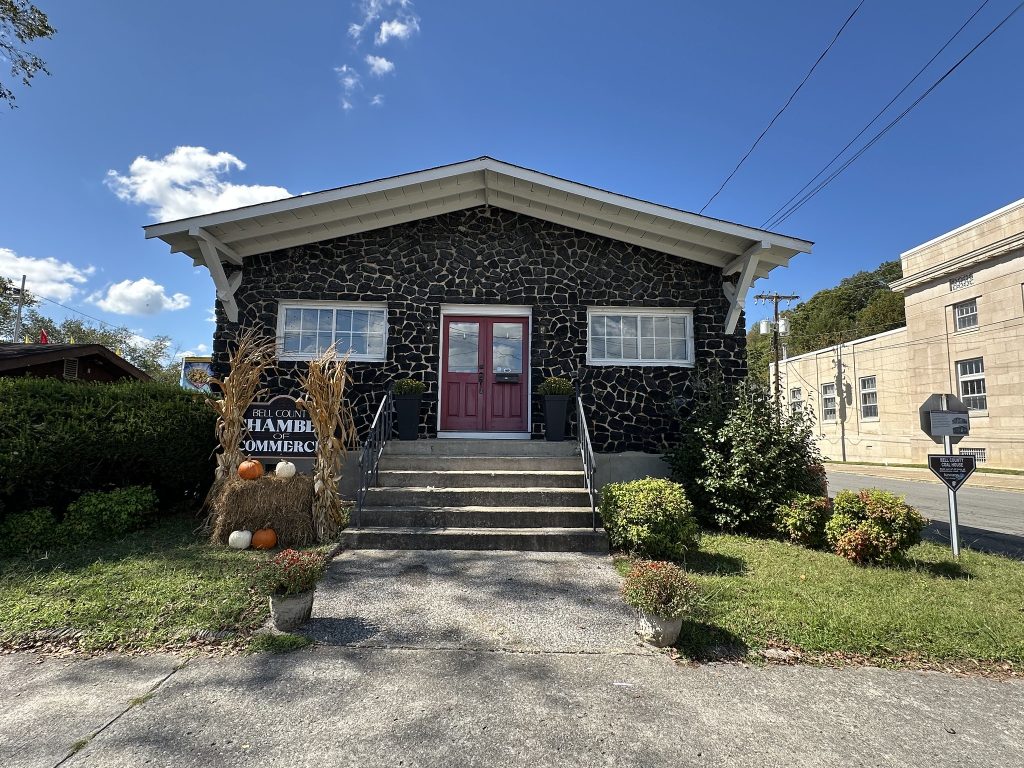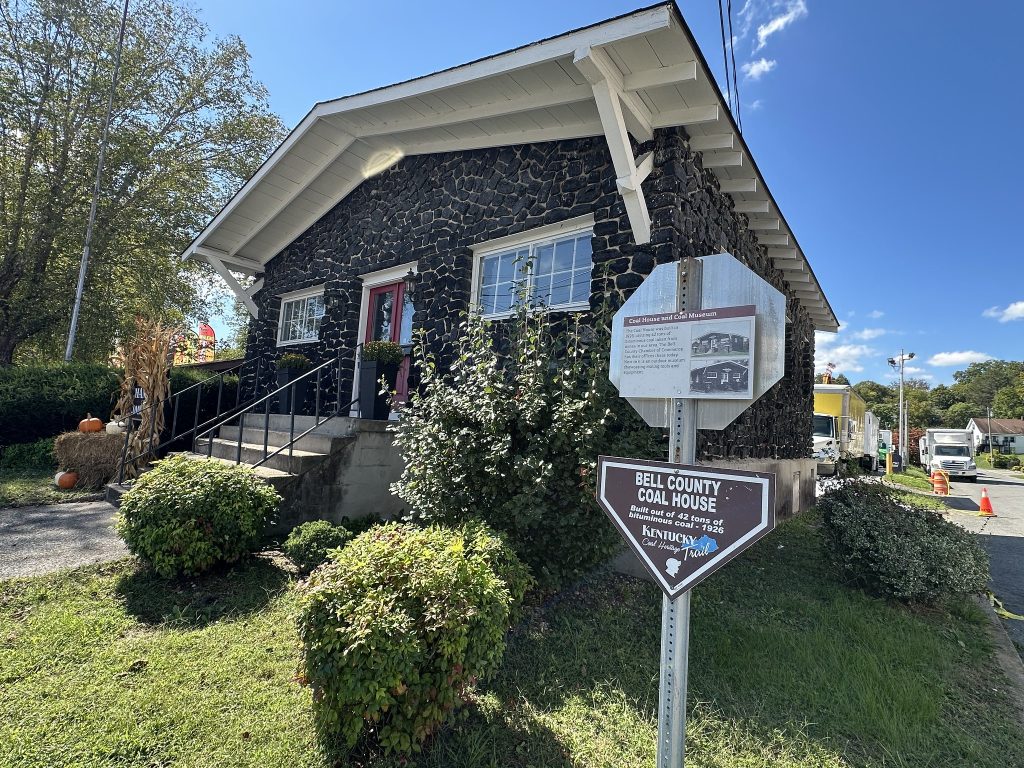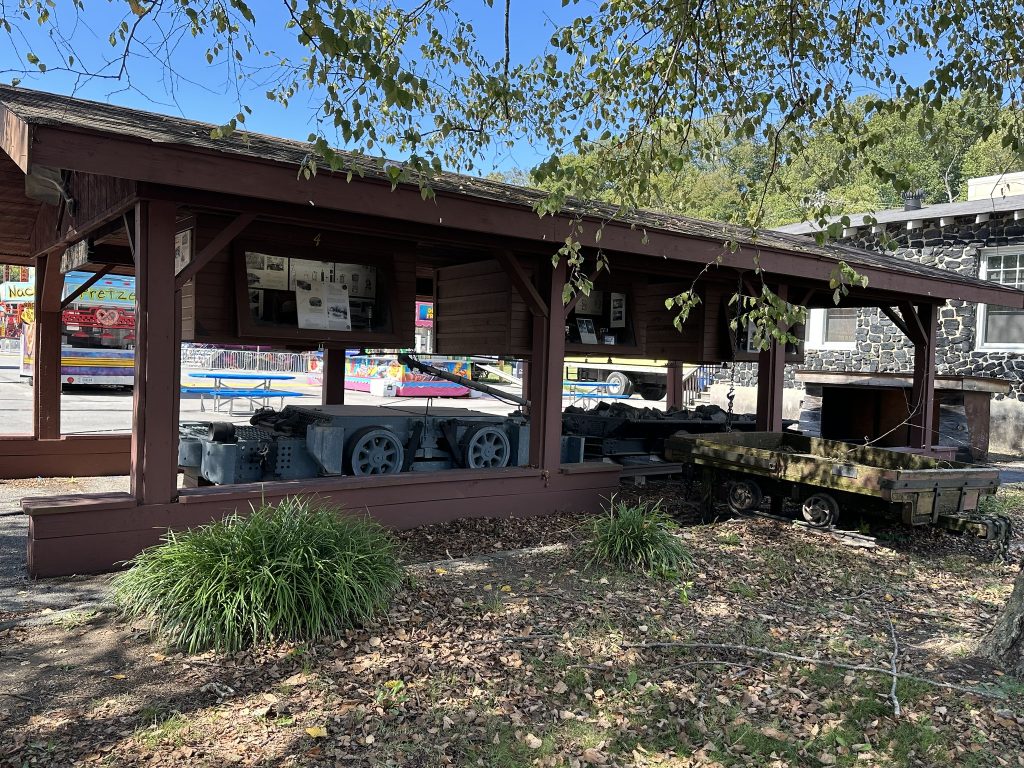Repurposed Appalachia Series

On the corner of North 20th Street in downtown Middlesboro sits a building that looks like it should not exist for very long. Walls glint with a dull black sheen, blocks pitted and irregular, as if the house had been carved straight out of a coal seam. For nearly a century, though, the Bell County Coal House has done exactly what its builders hoped it would do. It has advertised local coal to visitors, anchored the Chamber of Commerce, and now welcomes travelers into a small museum that explains why this corner of Appalachia mattered so much to the industrial age.
The Coal House is not the only coal building in the mountains, but it is one of the earliest and best known. It grew out of Middlesboro’s boomtown ambitions in the 1920s, survived a late twentieth century tornado, and today stands as a compact monument to coal boosterism and community memory.
Middlesboro’s Boomtown Dreams
Middlesboro did not grow slowly out of a crossroads settlement. It was planned. In the late 1880s, Canadian engineer Alexander Arthur and the British backed American Association laid out a new industrial city in a broad valley just west of Cumberland Gap, complete with wide streets, plazas, and brick commercial blocks. The goal was simple and audacious: turn Bell County’s coal and iron deposits into a southern Pittsburgh.
The city’s commercial heart took shape along Cumberland Avenue and its cross streets, including 20th Street. When the National Park Service listed the Middlesboro Downtown Commercial District on the National Register of Historic Places in 1983, it praised this area as one of the finest late nineteenth and early twentieth century business districts in eastern Kentucky and singled out “the Coal House, now the Chamber of Commerce, which is built entirely of coal” among its most distinctive buildings.
By the 1920s, rail lines, company offices, and hotels signaled that Middlesboro’s coal economy had matured. Civic leaders wanted a visual symbol that would be impossible to ignore, something that would turn their most important commodity into architecture.
A House Built of Coal
Local memory and later tourism literature agree on the basics. In 1926, over 42 tons of bituminous coal from nearby mines were fashioned into a one story, gable roofed building that became home to the Middlesboro Chamber of Commerce.
Photographs and on site views show a small structure with deep eaves, exposed brackets, and low stone like walls that give it an Arts and Crafts flavor. Regional heritage sites and social history pages explicitly describe it as an Arts and Crafts style building of locally mined coal, built as a tourist draw and later repurposed as the Chamber’s headquarters.
The coal itself appears to have been laid up in block form, with mortar binding irregular chunks into coursed walls. From a distance, the surface reads like dark fieldstone. Up close, the bands of bright vitrinite and duller shale show that this is not ordinary rock at all.
A 1928 nitrate negative from the Louisville firm Caufield and Shook captures the Coal House only two years after its construction. The image, preserved in the University of Louisville’s photographic archives, shows a trim little building in front of larger brick structures, with a sign over the door reading: “The Coal House, Middlesboro Chamber of Commerce, Middlesboro Kentucky, Tourist Information.” The catalog description notes plainly that it was “built entirely of coal in 1926” and that it served as a tourist information center for the Chamber.
In other words, the house was never meant to be a family dwelling. It was a billboard that people could walk into.

“Built Entirely of Kentucky Coal”: Postcards and Promotion
If the Coal House began as a civic showpiece, it quickly became a marketing image that traveled far beyond Bell County.
The Kentucky Historical Society’s postcard catalog lists a linen card produced by Curteich Chicago around 1930 titled “The Coal House, Home of the Chamber of Commerce, Middlesboro, Ky. Built Entirely of Kentucky Coal.” Like many Curteich cards of the period, it shows a bright, almost idyllic view of the building, set against a blue sky and lush lawn, with that slogan printed clearly beneath the image.
Other surviving cards repeat the caption nearly word for word. A reproduction hosted by KyKinFolk, drawn from a historic postcard, labels the scene: “THE COAL HOUSE HOME OF THE CHAMBER OF COMMERCE MIDDLESBORO, KENTUCKY – built entirely of Kentucky coal.” Vintage cards sold through dealers and archive sites today preserve the same language and layout, sometimes with handwritten messages and postmarks that show tourists were still mailing the Coal House home in the 1940s.
Even federal records picked up the image. A Catalog of Copyright Entries for photographic works lists “Middlesboro, Ky., the coal house” among a series of Kentucky views, evidence that professional photographers considered the building a scene worthy of national circulation.
In industrial promotion, the building became a talking point in its own right. A mid twentieth century booklet titled Industrial Resources: Bell County – Middlesboro touted the community’s assets and described the structure as “the oldest coal house serving as a chamber of commerce in the United States,” folding it neatly into a narrative of industrial pride.
Together, these primary records show how Middlesboro’s business leaders wanted visitors to see them. The Coal House did not hide the mechanics of extraction or the scars of mining. Instead it bordered on self parody, a literal house of coal that declared Bell County’s product strong enough to stand on its own, laid block by glossy block.
Opening Day and Local Memory
The exact day the Coal House opened has proved slippery for historians, but local newspapers have preserved a trail. A 2018 “This week in local history” column in the Middlesboro News looks back to 1926 and notes the “official opening of the Coal House” that year, locating it on the north side of Cumberland Avenue between 18th and 19th Streets. Contemporary issues of the Middlesboro Daily News from that week likely carried fuller coverage, including speeches and dedication ceremonies, though those still await careful review in microfilm or digital form.
Even without the full opening day story, early visual sources confirm that the building quickly settled into its downtown role. By the late 1920s, the Caufield and Shook negative already shows it operating as a tourist information center. The National Register nomination, written in the early 1980s, still finds it functioning as the Chamber of Commerce and calls its coal construction out as unusual among the district’s brick and stone buildings.
A Curiosity in Coal Country
Architectural historians sometimes group the Bell County Coal House with other oddball American structures built from local geological materials: petrified wood gas stations, coral rock houses in Florida, and later coal houses in West Virginia and elsewhere. The Kentucky Coal Heritage “Historic Context” survey calls Middlesboro’s Coal House a “true curiosity” among buildings constructed from local stone and mineral resources.
This curiosity had a competitive edge. When Williamson, West Virginia, built its own coal house in 1933 a structure that now houses the Tug Valley Chamber of Commerce Kentucky promoters were quick to stress that Middlesboro’s version was older. The claim in Industrial Resources that Bell County possessed “the oldest coal house serving as a chamber of commerce in the United States” was more than trivia. It was a way of reclaiming Appalachian novelty on Kentucky’s terms, reminding potential investors and tourists that Middlesboro had embraced the gimmick first.
At the same time, the Coal House hints at how civic leaders wanted to frame coal. In postcard art, the structure stands in manicured isolation, far from the dust and danger of underground work. There are no tipples, no gob piles, no company houses. Coal appears not as a raw rock hauled from the seam but as a tidy, almost domesticated building material.
Tornado, Repair, and Three Quarters of a Coal House
The most violent chapter in the Coal House’s story did not come from fire or subsidence but from a storm.
Regional tourism guides and roadside travel sites describe a late 1980s tornado that tore through Middlesboro and ripped away the back portion of the Coal House. Over 42 tons of coal had gone into the original walls. When the storm passed, enough damage had been done that the rear section had to be rebuilt with modern materials, later clad in vinyl siding. One popular travel writer jokes that the building is now “only three quarters of a coal house,” but notes that an outdoor coal mining exhibit grew up beside it in the same period.
Local news coverage lends more detail. In 2020, WYMT reported on plans for the Bell County Chamber of Commerce to move back into the historic Coal House after a period housed elsewhere. Executive Director Sheila Durham described the structure as more than 90 years old, built from 42 tons of coal, and recounted how a tornado in the late 1980s damaged both the coal walls and the roof. The Chamber’s restoration goals included sealing the coal surface to slow weathering and keep the building intact for decades to come.
That mix of humor and concern captures how locals saw the structure by the turn of the twenty first century. The Coal House was still a gimmick, still good for a story or a roadside photo, but it was also an aging artifact that needed real preservation work.

From Booster Office to Museum
For most of its life, the Coal House served as the headquarters for the Middlesboro or Bell County Chamber of Commerce. That function shaped both the original sign over its door and the steady stream of brochures, postcards, and maps that likely piled up inside.
By the early twenty first century, the building had taken on a more formal interpretive role. Kentucky tourism agencies and heritage campaigns now promote it as the Bell County Coal House and Museum, highlighting both the coal construction and the small exhibit that features local mining equipment and photographs outside or in an adjacent structure. They emphasize that the building contains 42 tons of bituminous coal and describe it as a “one of a kind” attraction in downtown Middlesboro.
Regional travel guides encourage visitors to begin their tour of Cumberland Gap country at the Coal House, noting that it stands along North 20th Street near the heart of historic downtown, with the visitor center and coal mining display next door.
In practice, that means the structure has been repurposed rather than frozen. It still houses the Chamber at times, still hosts community meetings, and still functions as a place where locals and outsiders talk about the region’s future. The difference is that those conversations now unfold inside a building that is itself a curated artifact of coal’s past.
Why the Coal House Matters
It would be easy to treat the Bell County Coal House as a roadside oddity, no more important than a giant coffee pot or concrete dinosaur. Yet when we put it back into the context of 1920s Middlesboro and the longer history of Appalachian coal, several themes emerge.
First, the building embodies a particular moment in coal boosterism, when local leaders tried to soften and celebrate an extractive industry by turning it into tourism. The Coal House does not talk about miners’ bodies or union drives or black lung. It talks about coal as a miracle material that can hold up a roof and greet visitors with potted geraniums on the steps.
Second, it demonstrates how quickly such images went national. Within a few years of its construction, postcards, copyrighted photo sets, and industrial brochures were circulating images of the Coal House around the United States. For people who never would have set foot in Bell County, “Middlesboro, Ky., the coal house” became a kind of shorthand for an entire coalfield.
Third, its survival and repair tell their own story. The tornado damage, vinyl sided rear wall, and ongoing preservation efforts show that communities do not simply preserve heritage. They patch it, seal it, and sometimes compromise to keep it standing. Today the structure is no longer entirely coal, and that is all right. It carries the layered evidence of both the coal boom and the later era of tourism and historic preservation.
Finally, the Coal House reminds us that the built environment can be both literal and symbolic at the same time. Its walls really are made from the substance that shaped Bell County’s economy and environment. Yet the building is also a carefully crafted message about that substance, one that says as much about how Middlesboro wanted to be seen as it does about what lay underground.
Visiting Today
Visitors who come to Middlesboro to see the Cumberland Gap, explore downtown, or follow regional coal heritage trails can find the Bell County Coal House at roughly 189 North 20th Street, within the National Register listed commercial district. Tourism sites describe it as housing a small museum and coal mining exhibit, with the Chamber of Commerce often sharing the space.
If you go, look closely at the walls. You can see the variation in coal thickness, the seams of mortar, and the places where weather and repairs have left their mark. Then step back and imagine the building as it appeared on those 1930s postcards, framed by bright colors and proud captions that promised a city built on coal and ready for the world.
Sources & Further Reading
Caufield and Shook, “Coal house, Middlesboro Chamber of Commerce Tourist Information, Middlesboro, Kentucky,” nitrate negative, 25 September 1928, University of Louisville Digital Collections, item ULPA CS_095566.
Kentucky Historical Society, Madisonville – Murray postcard catalog, listing for “The Coal House, Home of the Chamber of Commerce, Middlesboro, Ky. Built Entirely of Kentucky Coal. Curteich Chicago 1930.”
“Chamber of Commerce Middlesboro, Ky,” reproduced postcard image at KyKinFolk / USGenWeb Bell County site.
“The Coal House, Home of the Chamber of Commerce, Middlesboro, Kentucky,” linen postcard, CardCow vintage postcard listing with scans of front and back.
“Middlesboro, Ky., the coal house,” listed in Catalog of Copyright Entries, New Series. Part 4: Works of Art (photographic series of Kentucky views).
“This week in local history,” Middlesboro News, 19 November 2018, retrospective note on 1926 “official opening of the Coal House.”
David Morgan, “Middlesboro Downtown Commercial District,” National Register of Historic Places nomination, National Park Service, 1982.
Kentucky Coal Heritage, “Historic Context” page, section on buildings constructed from indigenous geological materials.
Explore KY Wildlands, “Coal” heritage page and “Bell County Coal House and Museum in Middlesboro” attraction listing.
Cumberland Gap Region Tourism Association, “Museums” page, entry for Bell County Coal House and Museum.
Roadside America, “Coal House, Coal Museum – Middlesboro, KY.”
WYMT, “Bell County Chamber of Commerce set to move back into historic Coal House,” 16 July 2020.
Kentucky Living magazine, “Crater City,” feature on Middlesboro, 25 September 2025.
Real Appalachia, “Coal House in Middlesboro, Kentucky” social media post, 2024, describing Arts and Crafts style and history.
Industrial Resources: Bell County – Middlesboro (mid twentieth century industrial survey and promotional booklet).